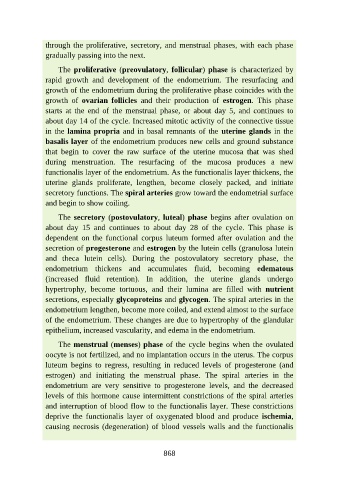Page 869 - Atlas of Histology with Functional Correlations
P. 869
through the proliferative, secretory, and menstrual phases, with each phase
gradually passing into the next.
The proliferative (preovulatory, follicular) phase is characterized by
rapid growth and development of the endometrium. The resurfacing and
growth of the endometrium during the proliferative phase coincides with the
growth of ovarian follicles and their production of estrogen. This phase
starts at the end of the menstrual phase, or about day 5, and continues to
about day 14 of the cycle. Increased mitotic activity of the connective tissue
in the lamina propria and in basal remnants of the uterine glands in the
basalis layer of the endometrium produces new cells and ground substance
that begin to cover the raw surface of the uterine mucosa that was shed
during menstruation. The resurfacing of the mucosa produces a new
functionalis layer of the endometrium. As the functionalis layer thickens, the
uterine glands proliferate, lengthen, become closely packed, and initiate
secretory functions. The spiral arteries grow toward the endometrial surface
and begin to show coiling.
The secretory (postovulatory, luteal) phase begins after ovulation on
about day 15 and continues to about day 28 of the cycle. This phase is
dependent on the functional corpus luteum formed after ovulation and the
secretion of progesterone and estrogen by the lutein cells (granulosa lutein
and theca lutein cells). During the postovulatory secretory phase, the
endometrium thickens and accumulates fluid, becoming edematous
(increased fluid retention). In addition, the uterine glands undergo
hypertrophy, become tortuous, and their lumina are filled with nutrient
secretions, especially glycoproteins and glycogen. The spiral arteries in the
endometrium lengthen, become more coiled, and extend almost to the surface
of the endometrium. These changes are due to hypertrophy of the glandular
epithelium, increased vascularity, and edema in the endometrium.
The menstrual (menses) phase of the cycle begins when the ovulated
oocyte is not fertilized, and no implantation occurs in the uterus. The corpus
luteum begins to regress, resulting in reduced levels of progesterone (and
estrogen) and initiating the menstrual phase. The spiral arteries in the
endometrium are very sensitive to progesterone levels, and the decreased
levels of this hormone cause intermittent constrictions of the spiral arteries
and interruption of blood flow to the functionalis layer. These constrictions
deprive the functionalis layer of oxygenated blood and produce ischemia,
causing necrosis (degeneration) of blood vessels walls and the functionalis
868

